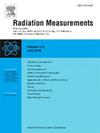Thermoluminescence and optically stimulated luminescence dosimetry with NaCl detectors made at different sintering temperatures
IF 2.2
3区 物理与天体物理
Q2 NUCLEAR SCIENCE & TECHNOLOGY
引用次数: 0
Abstract
Salt (NaCl) is well known as a thermoluminescence (TL) and optically stimulated luminescence (OSL) phosphor that has potential for emergency dosimetry. Using grains of Alpine salt with iodine (Saline Reichenhall, Germany) purchased in a local grocery, detectors in the form of pellets were made. Some of them were sintered at temperatures of 400, 500 and 600 °C. TL and OSL dosimetry characteristics as sensitivity, sensitization, minimum detectable dose (MDD), dose response, energy response and fading were investigated for both the sintered and unsintered detectors. While sintering improved the potential of the detectors for TL dosimetry, the opposite was true for OSL dosimetry. For the sintered detectors, a distinct high-temperature stable TL peak was observed. However, due to its strong sensitization and dose response, the use of the Single-Aliquot Regenerative-dose (SAR) protocol is required for dose reconstruction. The dose response of the OSL signal of sintered detectors already showed saturation for doses in the order of tens of mGy, which excluded them from use for emergency dosimetry. In contrast, the OSL signal of unsintered detectors was distinguished by moderate sensitization and dose response allowing for the use of a simple analytical protocol. MDD values obtained for all the groups of detectors were less than 0.1 mGy. Both the TL and OSL signals monitored within 3 months after irradiation exhibited inverse fading. The energy response suggests that the detectors are suitable for applications in high-energy gamma radiation environment (>200 keV), especially if they are not part of a complex dosemeter with an appropriate filtration and algorithm. The comparison of the obtained characteristics of the investigated groups of salt detectors shows that the needs and requirements of emergency dosimetry are best met by the unsintered OSL detectors.
不同烧结温度下NaCl探测器的热释光和光激发发光剂量测定
盐(NaCl)是一种众所周知的热释光(TL)和光激发发光(OSL)荧光粉,具有应急剂量测定的潜力。使用从当地杂货店购买的含碘的高山盐颗粒(德国盐碱厂Reichenhall),制成颗粒状的探测器。其中一些在400、500和600℃的温度下烧结。对烧结和未烧结探测器的TL和OSL剂量学特性进行了灵敏度、敏化、最小可探测剂量(MDD)、剂量响应、能量响应和衰减研究。虽然烧结提高了探测器在TL剂量测定中的潜力,但在OSL剂量测定中却相反。烧结后的探测器有明显的高温稳定TL峰。然而,由于其强致敏性和剂量反应,需要使用单aliquot再生剂量(SAR)方案进行剂量重建。烧结探测器的OSL信号的剂量响应已经显示出几十毫戈瑞量级的剂量饱和,这使它们不能用于应急剂量测定。相比之下,未烧结探测器的OSL信号被区分为中等敏化和剂量响应,允许使用简单的分析方案。所有探测器组的MDD值均小于0.1 mGy。照射后3个月内监测到的TL和OSL信号均呈反向衰减。能量响应表明,探测器适用于高能伽马辐射环境(> 200kev),特别是如果它们不是具有适当过滤和算法的复杂剂量计的一部分。对所研究的几种盐探测器的特性进行了比较,表明未烧结的OSL探测器最能满足应急剂量测定的需要和要求。
本文章由计算机程序翻译,如有差异,请以英文原文为准。
求助全文
约1分钟内获得全文
求助全文
来源期刊

Radiation Measurements
工程技术-核科学技术
CiteScore
4.10
自引率
20.00%
发文量
116
审稿时长
48 days
期刊介绍:
The journal seeks to publish papers that present advances in the following areas: spontaneous and stimulated luminescence (including scintillating materials, thermoluminescence, and optically stimulated luminescence); electron spin resonance of natural and synthetic materials; the physics, design and performance of radiation measurements (including computational modelling such as electronic transport simulations); the novel basic aspects of radiation measurement in medical physics. Studies of energy-transfer phenomena, track physics and microdosimetry are also of interest to the journal.
Applications relevant to the journal, particularly where they present novel detection techniques, novel analytical approaches or novel materials, include: personal dosimetry (including dosimetric quantities, active/electronic and passive monitoring techniques for photon, neutron and charged-particle exposures); environmental dosimetry (including methodological advances and predictive models related to radon, but generally excluding local survey results of radon where the main aim is to establish the radiation risk to populations); cosmic and high-energy radiation measurements (including dosimetry, space radiation effects, and single event upsets); dosimetry-based archaeological and Quaternary dating; dosimetry-based approaches to thermochronometry; accident and retrospective dosimetry (including activation detectors), and dosimetry and measurements related to medical applications.
 求助内容:
求助内容: 应助结果提醒方式:
应助结果提醒方式:


